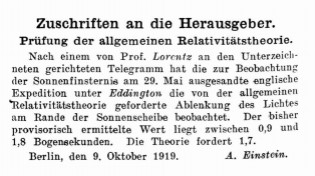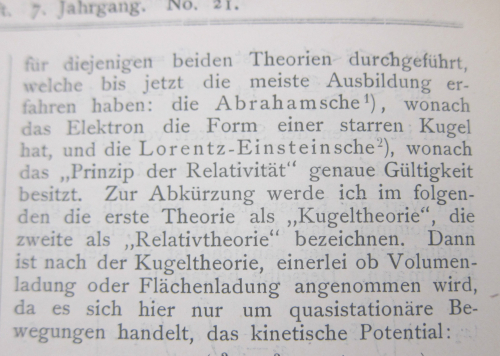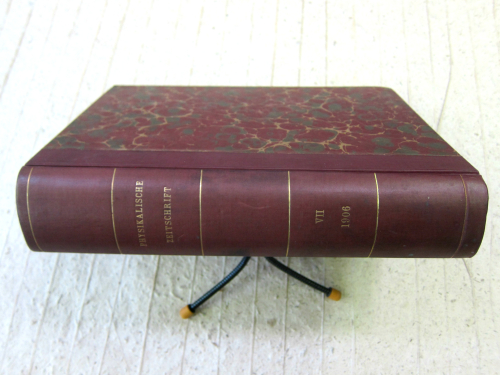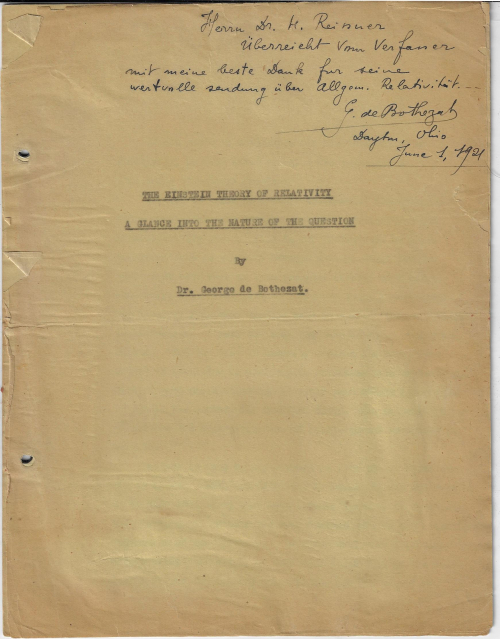Einstein, Albert. "Zuschriften an die Herausgeber, Prufung der allgemeinen relativitatstheorie", in Die Naturwissenschaften, volume 7, heft 42, October 17, 1919. p 776 in the issue of pp (761)-780, offered in the original wrappers, removed from a larger bound volume. Condition: the wrappers are browned somewhat. given the supply of paper in the broken German economy of 1919, but the text paper is unaffected, being pretty much blemish-free, though slightly dulled to one of the myriad descriptors of "pale white" or "eggshell"...anyway, quite but not brilliantly so. The announcement comes from Einstein himself, and is one short paragraph long. Given that the tiny notice appears in what looks like a short index on the front of the magazine that it was being given some sort of prestige, it wasn't--every entry in the short issue is listed there, so no big deal on finding the Einstein on the front cover. Very nice copy. sold
- This seems to be the earliest mention of confirming results of the 1919 expeditions to confirm GTR, submitted by Einstein himself weeks before the formal announcement at the Royal Institution. There was at least one newspaper story on the eclipse--with the information again supplied by Einstein from a telegraphic communication from Lorentz--but I cannot locate the article to see if any of the figures were included in the story. I cannot find any evidence that an article or notice appeared in a scientific journal before this and it seems unlikely that it would be so. Also a few simple Google searches on the title and author of the announcement reveals, well, almost nothing, which was unexpected. But "unlikely" is hardly definitive, and so the qualified (and questioned) "firstness" of the announcement.
According to Abraham Pais, an "excited" Albert Einstein contributed a very short note ("Zuschriften an die Herausgeber, Prufung der allgemeinen relativitatstheorie"/"A Test of the General Theory of Relativity") to the editors of the journal Die Naturwissenschaften1 reporting on the telegram he had received from H.A. Lorentz on September 22 on the impending confirmation of the theory of relativity as it was tested in the May 29, 1919 eclipse experiments organized by Sir Frank Dyson. Chandrasekhar explains the situation so:
- "It was some months before the two expeditions returned to England and the participants were able to measure their plates and collate their results. But rumours of the successful confirmation of Einstein's prediction reached Einstein in early September 1919. And on 22 September 1919, the Dutch physicist Hendrik Antoon Lorentz sent Einstein a telegram confirming the rumours to which Einstein replied (also by telegram).. Einstein's own satisfaction with the outcome of the British expeditions is shown by the postcard (dated September 27, 1919) to his ailing mother in Switzerland. It said: Dear Mother: Good news today. H. A. Lorentz has wired me that the British expeditions have actually proved the light deflection near the Sun...."
"The telegram that had announced the news to Einstein...was an informal communication. Nothing was definitive. Yet Einstein sent almost at once a very brief note to Naturwissenschaften for the sole purpose of reporting the telegram he had received. He was excited." (Pais, Subtle is the Lord, p 303).
Einstein's note in Naturwissenschaften was concise and to the point: "...the English expedition, under Eddington...has observed the deflection of light at the limb of the sun demanded by the General Theory of Relativity3..."
The results of the experiment were read on November 6, 1919 (the presentation begun by Dyson, followed by A. C. Crommelin, the leader of the Sobral expedition) to a joint meeting of the Royal Society and the Royal Astronomical Society, and famously published in the Philosophical transactions of the Royal Society in 1920 as “A Determination of the Deflection of Light by the Sun’s Gravitational Field, from Observations Made at the Total Eclipse of May 29, 1919”4. J.J. Thomson (as president of the Royal Society) closed the meeting and “pronounced the canonization [of Einstein]”: 'This is the most important result obtained in connection with the theory of gravitation since Newton’s day, and it is fitting that it should be announced at a meeting of the society so closely connected with him. . . . The result [is] one of the highest achievements of human thought.' (Pais, Subtle..., in the chapter “The Suddenly Famous Doctor Einstein”, p 305) R.H. Fowler, president of the Royal Astronomical, also spoke and announced '“The conclusion is so important that no effort should be spared in seeking confirmation in other ways.”
The Einstein note is dated October 9 in the text and was published a week later in the issue of October 17, 1919. It is one of the first appearances on the confirmation of the theory, with the exception, evidently, of at least one notice in a Berlin newspaper5 just days earlier. (Again, this according to Pais.) It would be on November 6 that "Lorentz sent another telegram to Einstein, confirming the news. On November 7, 1919, the Einstein legend began." I assume that Pais is talking about the general article that appeared in the London Times on that day (and which would be written for the New York Times on the 9th, and then it was off to the races with the news, with Einstein himself contributing an article three weeks later to The Times). Well, "off to the races" except in Germany, where the reporting beyond this notice in Naturwissenschaften was more reserved, as noted by an article on the 1919 eclipse on the Max Planck Gesellschaft website: "In contrast to the enthusiastic reception shown by the foreign press, the media in Germany were more reticent on the subject. Not until 14 December 1919 did the Berliner Illustrierte Zeitung publish a photo of Einstein and an article entitled: “A new luminary for the history of the world: Albert Einstein, whose research means a total revolution in the way we see the world and whose findings are equal to those of a Copernicus, Kepler and Newton”.
Here's the entire announcement from Naturwissenschaften:

Writing about the eclipse on his website, Simon Singh says that J.P. McEvoy, author of Eclipse: The Science and History of Nature’s Most Spectacular Phenomenon (Fourth Estate Ltd., 1999), "encapsulated the significance of the announcement" writing of the ironies of the event: "A new theory of the universe, the brain-child of a German Jew working in Berlin, had been confirmed by an English Quaker on a small African island." A further bit to add here is that the expeditions were undertaken by British scientists to prove the work of a German scientist, beginning their work before the end of WWI.
S. Chandrasekar reports that in 1933 Rutherford expounded on the eclipse and Einstein's fame, rather more broadly and more deeply:
"The war had just ended: and the complacency of the Victorian and the
Edwardian times had been shattered. The people felt that all their values and
all their ideals had lost their bearings. Now, suddenly, they learnt that an
astronomical prediction by a German scientist had been confirmed by
expeditions to Brazil and West Africa and, indeed, prepared for already
during the war, by British astronomers. Astronomy had always appealed to
public imagination; and an astronomical discovery, transcending worldly
strife, struck a responsive cord. The meeting of the Royal Society, at which
the results of the British expeditions were reported, was headlined in all the
British papers; and the typhoon of publicity crossed the Atlantic. From that
point on, the American press played Einstein to the maximum..."6
I guess this is where the ultra-fame of Einstein begins.
Notes:
1. Die Naturwissenschaften, volume 7, heft 42, October 17, 1919. p 776
2. S. Chandrasekhar, “Verifying the Theory of Relativity”, in Notes and Records of the Royal Society of London Vol. 30, No. 2 (Jan., 1976), pp. 249-260.
3. The Collected Papers of Albert Einstein, Volume 7 (English).
4. W. Dyson, A. S. Eddington, C. R. Davidson, “A Determination of the Deflection of Light by the Sun’s Gravitational Field, from Observations Made at the Solar eclipse of May 29, 1919”, Philosophical Transactions of the Royal Society, A 220 (571-581): 291–333 (1920). Eddington had written previously on the expedition, "The total eclipse of 1919 May 29 and the influence of gravitation on light”, in The Observatory, Vol. 42, p. 119-122 (1919)
5. "An article by Alexander Moszkopwski entitled 'Die Sonne bracht es an den Tag' in the Berliner Tageblatt of October 8, 1919, must presumably have been based in information from Einstein himself". (Pais, Subtle..., footnote p 306.) Also, Andrew Claude de la Cherois Crommelin contributed “The Eclipse Expedition to Sobral” in The Observatory 42, 368-371, and though it published in October there is no mention of definitive results yet. Crommelin also publishes an article in Nature on 13 November (volume 104, p. 280-1), appearing about a week after the Royal Society meeting, in which he publishes the results, all on the equivalent of a single page.
6. Chandrasekhar, ibid., pg 251.
[Interesting to note here that in Maurice Lecat's Bibliographie de la Relativite (1924) this contribution receives only a scant placement within the Einstein section, in part 13 (c).]





